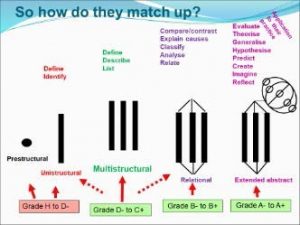How to get an A Grade
By Dawn Goodall, Senior Lecturer in the Department of Health and Wellbeing and Learning and Teaching Co-ordinator; School of Allied Health and Community

As part of the Post Graduate Certificate in Higher Education we were introduced to the university’s Generic Undergraduate Grading Criteria (UW, 2016) [K6] and a fellow student commented if he had known this he would have ‘got a First’. This stuck in my head and after exploring Structure of Observed Learning Outcomes (SOLO) (Biggs and Collis, 1982; Biggs and Tang, 2007), I decided to design a session for students on assessment grading (A2). I explored grade differences using key vocabulary/ideas in the descriptors’, sporting analogies, physical demonstrations with books and hypothetical authorship. This addressed different learning styles (A4) by providing multiple means of representation (BrackenandNovak,2019) [V3] while avoiding rigid classification (Cranton,2006) (V1; V2).
Initially designed as a student item, it became clear to me that some staff lacked confidence to articulate grade development, especially as assessment can be intimidating when staff feel “exposed in every judgement you make” (Becker and Denicolo, 2013; p137). I came to believe that effective and accurate assessment of a student’s ability to meet SOLO was both a ‘science’ and an ‘art’. Therefore, I redeveloped my teaching tool to demonstrate how marking can be visualised using these same representations (K3). Once staff grasp the ‘science’ of the structure under observation, then they can apply the “art” of subject knowledge and skill (K1).
Initially, staff delivery was for collaborative partnerships (V4), the impact of this on a new partner illustrates the importance of this tool in developing excellence. [It] “Helped with my marking of assessments to a greater degree and most importantly my students … seemed to have that ‘awh!’ moment…grades were improving” (V1; A4).
Similarly, an established collaborative marker stated, “Grading decisions become almost instinctive. …I use the diagram and your explanations particularly with teachers who are new to our team … remind me of what I should be looking for. … invaluable and because of the very visual nature of the diagrams and the generic example used it is so relatable”.
I now use the tool for staff training across the School to support new markers (A5). I also deliver this to Level 5 and 6 students from other Schools, getting regular feedback ‘this is something that we should have known from the start’.
I led a Share and Inspire session: “De-mystifying the University Generic Grading Criteria: How to get an A grade” (RLO) (K4; A1) to create a student-facing Reusable Learning Object (RLO), and received positive feedback “…I have just treated myself to watching your seminar on Uniview (UW,2019).
I would say this is one of the best ways I have spent 45 minutes ever! … particularly useful for new members of staff”.
The RLO has been Tweeted as advice for staff seeking sources to develop assessment success (Twitter,14.5.2019) and suggested by staff for inclusion in their induction to support confident marking. The Academic Liaison Librarians commented that I have provided them with language tools and accessible ideas (A4; K3) “I will refer to your words again in future … wonderful way you paraphrased the awful academic jargon of learning outcomes etc.) … helps to provide a context … to use references effectively”.
I have recognised my ability to make complex ideas more accessible and gaining validation of this from my peers has enhanced my sense of professional identity and I plan to develop additional work in this area going forward.
References
Becker, L. and Denicolio, P. (2013) Teaching in higher education. London: Sage
Biggs, J.B. and Collis, K.F. (1982). Evaluating the Quality of Learning: the SOLO taxanomy. New York: Academic Press.
Biggs, J. and Tang, C. (2007) Teaching for Quality Learning at University. Open Up.
Bracken, S and Novak, K. (2019) Transforming higher education through Universal Design for Learning: an international perspective. London: Routledge
Cranton, P. (2006) Understanding and Promoting Transformative Learning: A Guide for Educators of Adults – 2nd edn. San Francisco: CA: Jossey-Bass
University of Worcester (2016) Generic Undergraduate Grade Descriptors. [Online] available from: https://www.worc.ac.uk/aqu/documents/GenericUndergraduateGradeDescriptors.pdf (Accessed 16th September 2019)
University of Worcester (2019) Uniview: DGoodall: How to get an A grade 13Mar19 Available at: https://uniview.worc.ac.uk/View.aspx?id=19082~5h~zBbLwP8WBw (Accessed 16th September 2019)
